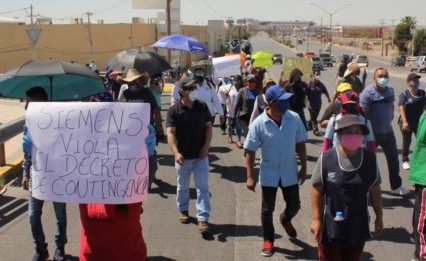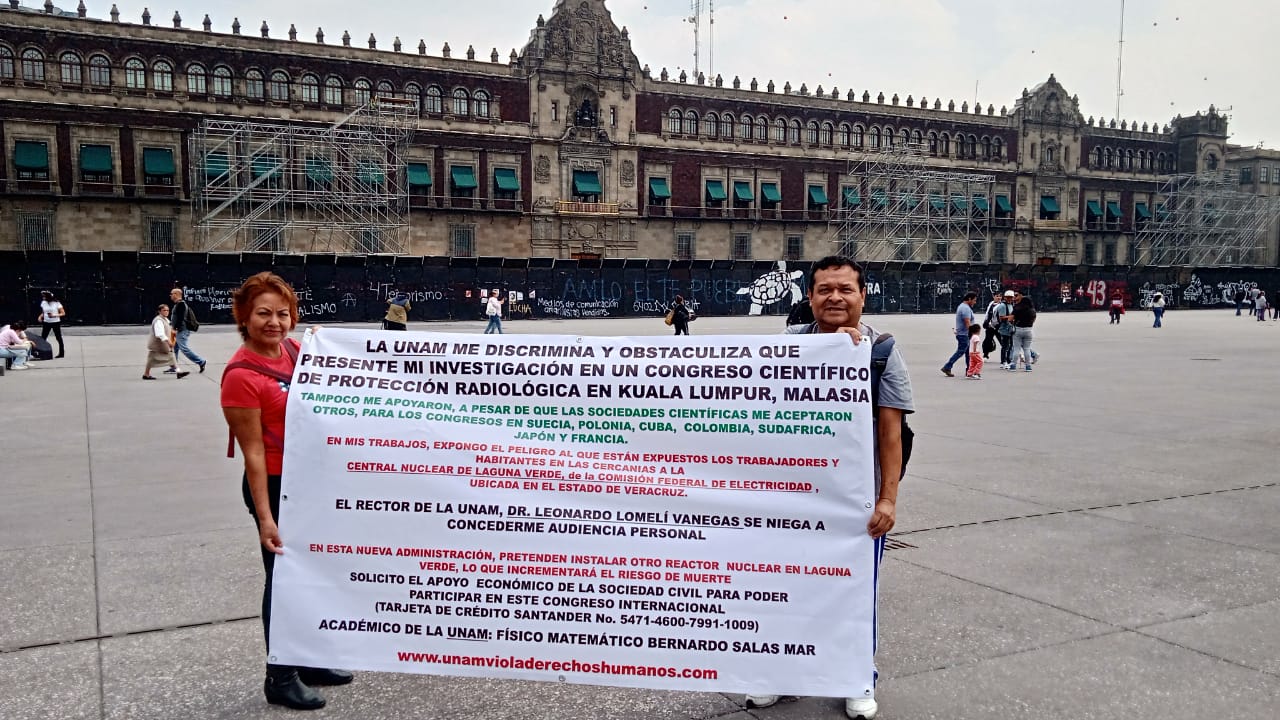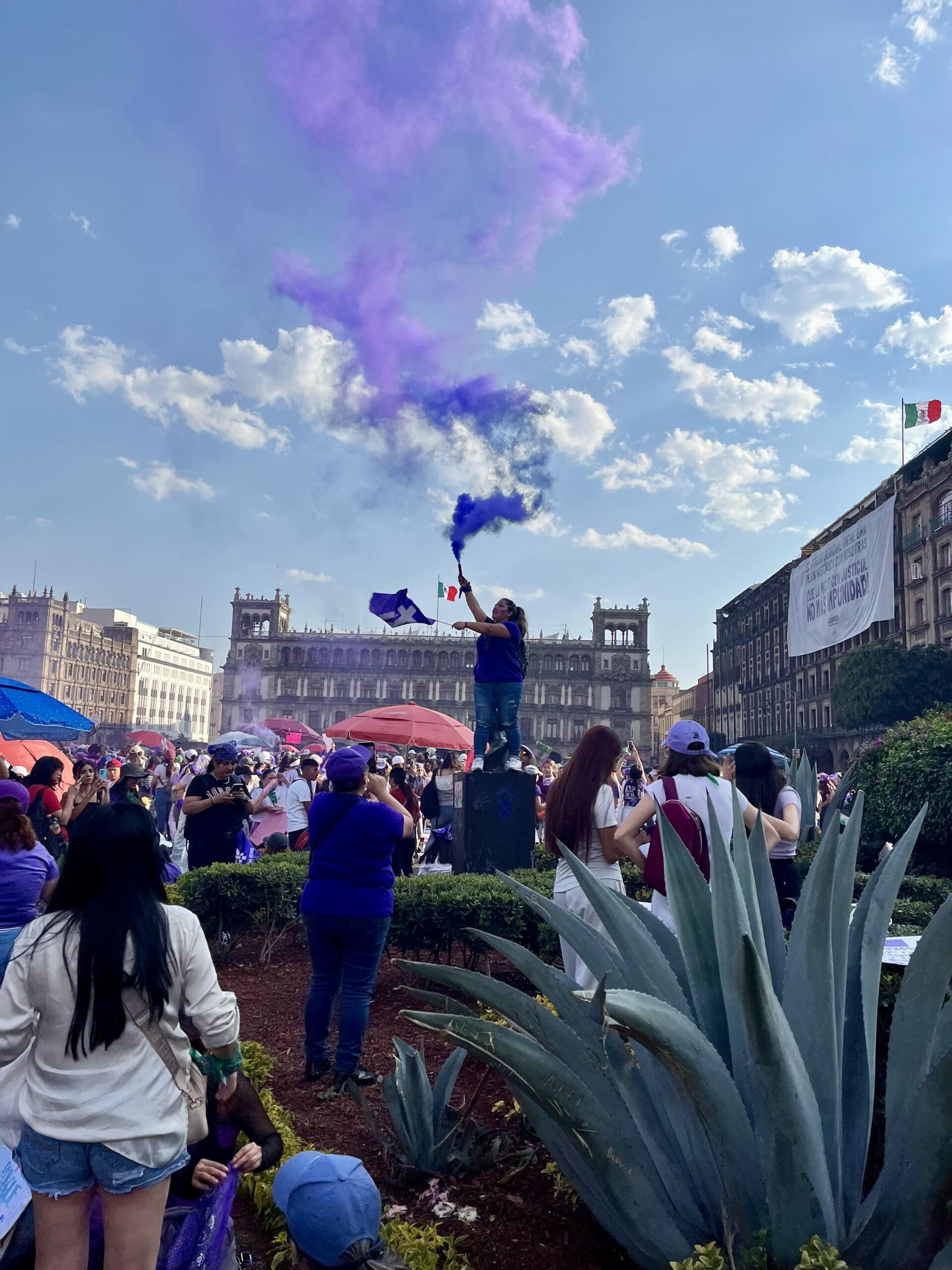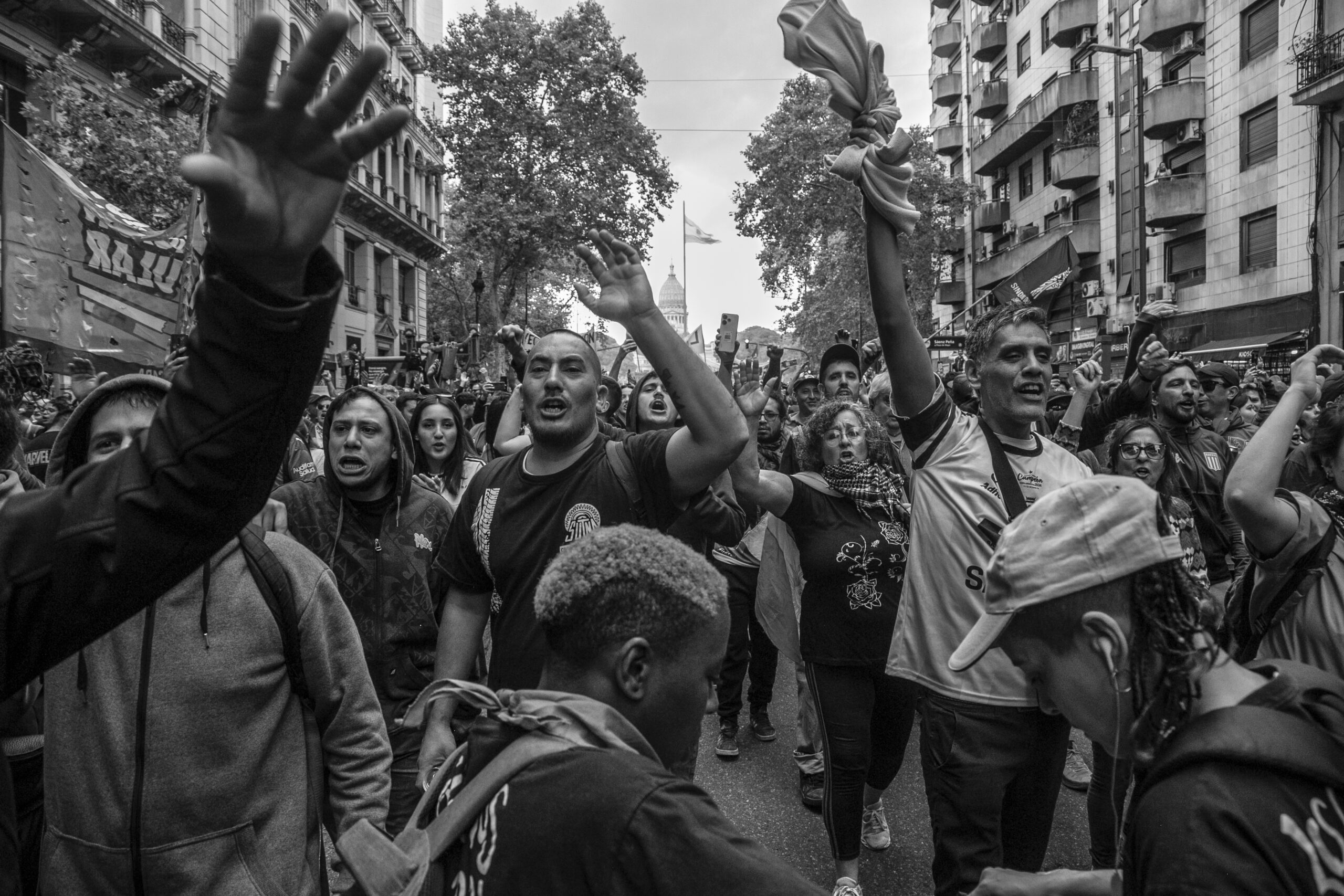 Ciudad Juarez has a long history of crises–foreign invasions, revolutions, economic recessions tied to the United States, the 9-11 border constriction and transnational gangland wars. Then there’s the perpetual crisis of putting food on the table in a high-priced, low-wage city while staying safe in a place where violence can surge at any moment.
Ciudad Juarez has a long history of crises–foreign invasions, revolutions, economic recessions tied to the United States, the 9-11 border constriction and transnational gangland wars. Then there’s the perpetual crisis of putting food on the table in a high-priced, low-wage city while staying safe in a place where violence can surge at any moment.
Heaped atop the struggles of daily life, the Mexican city of an estimated 1.5 million residents bordering El Paso, Texas, now grapples with the COVID-19 pandemic.
Longtime Juarez resident and activist Paula Flores knows the dynamic too well. As part of the wave of rural migrants who gravitated to the NAFTA boomtown in the last years of the 20th century, Flores’ family scrambled to make a living and build a home.
Her daughter, 17-year-old factory worker Sagrario, disappeared one day in 1998. Sagrario was later found murdered. Today’s pandemic, though, has left its own unique and ugly stamp on the city, Flores said in an interview.
After COVID-19 struck, Flores and her family nervously navigated a 10-day municipal curfew and a two-person-per vehicle limit during which police were reputed to detain and “fine” violators. They watched the economy contract, endured hours-long lines at supermarkets and felt the sting of rising living costs.
“All the food is expensive,” Flores said. “The only thing that’s gone down is gasoline. But many people don’t have cars, so what good is it?”
Keeping the children appropriately occupied since public schools closed has been another emergency task. The on-line lessons delivered by the schools last only so long and don’t reach many people without ready access to the Internet, Flores said. “(Government) doesn’t do anything about this, to make sure there is something for the children to do besides school work.”
Flores insists she hasn’t met anyone who contracted COVID-19 and blames the pandemic-driven business shutdowns and social restrictions for “killing people” by exacerbating emotional depression and creating joblessness.
Rising Violence against Women
The Juarez news site Laverdadjuarez.com recently reported that Juarez and the state of Chihuahua ranked first in Mexico for the number of emergency calls related to violence against women logged from January to the end of April this year.
Citing statistics from Mexico’s National Public Security System, the news publication reported that 753.3 such calls were made per 100,000 women in Chihuahua–a rate far above the national average of 136.2 calls per 100,000 women.
In another report, the official Chihuahua Women’s Institute informed that its statewide service centers had conducted 4,233 consultations and received 575 emergency calls from March 23 to June 7. Of the consultations, 924 were new cases, a 17 percent increase from the same period in 2019, according to the Institute.
“We had been expecting this,” said Institute Director Emma Saldana. “One of the impacts of confinement for girls, adolescents and women is that, the more time they’re exposed to their aggressors, the violence increases…”
According to Flores, the COVID-19 crisis undermined the broader effort to reduce gender violence in the area by suddenly consigning it to the back burner. The issue topped national discourse earlier this year, exemplified by the women’s movement that surged in Mexico prior to the pandemic and staged nationwide protests Mar. 8 and a strike Mar. 9.
Juarez activists were in the streets before the March events, protesting the February murder of Isabel Cabanillas, a young Juarez artist and member of the feminist organization Hijas de su Maquiladora Madre. Cabanillas’ murder remains unsolved.
COVID-19 prevented Flores and her allies from repainting the pink crosses on Juarez streets that call attention to the femicides that have taken the lives of so many Juarez women over the decades. The annual event had served as a reminder of the lack of justice.
Other forms of violence have also gone up with pandemic. A decade ago, Juarez acquired the moniker “Murder City” for the daily slaughter that ensued in the conflict between the Juarez and Sinaloa cartels over control of the drug trade. The intervention of federal police and the Mexican army ostensibly to restore order actually paralleled a rise in killings and violence.
The so-called hyperviolence coincided with the Great Recession, when tens of thousands of Juarez factory workers lost their jobs and a large segment of the population fled the city.
From 2012 to 2016 violence subsided, but did not go away. The economy revved back up, people returned and workers began demanding better employment conditions.
Violence began to escalate again in 2016-17, with recent killings linked to an arguably messier competition over control of illegal street drugs, especially methamphetamine, now waged by several underworld groups instead of just the former two dominant organizations.
Official numbers cited in the local press reported 703 homicides from January to the end of May, a rate comparable to the period of hyperviolence a decade ago. But observers pointed out that the number was really 712 since the authorities did not include nine persons killed by police. The latest murder numbers reposition Juarez as the number-two city in the country for homicides, only behind Tijuana, another Mexican border city engulfed in illegal drug market violence.
Criminal impunity is the constant in all manner of murders. The government ended p throwing one man in jail for Sagrario’s murder, but Flores has long maintained that others were involved. Nearly two years ago, she walked up to then-president elect Andres Manuel Lopez Obrador (AMLO) at a Juarez human rights forum and personally handed him information about Sagrario’s case. Flores said that no one from AMLO’s office ever contacted her to follow up.
A Hierarchy of Virus Victims
While violence revisits the streets of Juarez, the COVID-19 virus grinds away at the health and fabric of society in Juarez, in its sister city El Paso and other southern New Mexico cities. By mid-June, El Paso officially hit 100 deaths and almost 4,000 infections. Juarez, with approximately double the population of El Paso, reported slightly more than 1,800 infections and 388 deaths, according to a report in El Diario de Juarez based on state health department numbers.
Due to the testing shortfall and inadequate manner of tracking deaths, the Juarez numbers in particular are widely considered an undercount.
The disease has touched many Juarez families, including Mayor Armando Cabada, who tested positive for COVID-19. An early media narrative framed the pandemic as a health catastrophe that did not discriminate, but it soon became clear that segments of the population already at risk in “normal times”, including the poor, prisoners, the impoverished elderly, low income workers and migrants, were most vulnerable to a still incurable illness.
In 2018 and 2019, Juarez attracted thousands of people from Latin America and other parts of the world attempting to cross the border and seek U.S. political asylum. While waiting for their cases to be called up, many were forced to stay in Juarez by the Trump Administration’s Remain in Mexico policy, agreed to by AMLO’s administration
Asylum seekers, stranded in Juarez, crowded into hotels, apartments and privately or government-run migrant shelters. In May, El Diario reported that two workers and 12 Central and South American refugees had contracted the COVID-19 virus at the Leona Vicario Migrant Integration Center shelter operated by the Mexican federal government. Last December, the facility suffered a chickenpox outbreak that reportedly infected 180 people and led to weeks of quarantining. The center was built to house asylum seekers deported from the United States in large dormitory-style rooms.
Inaugurated in the summer of 2019, the new center was initially viewed by Mexican federal officials as a job recruitment center for the foreign-dominated maquiladora assembly plants and agricultural industries of northern Mexico, which had 50,000 open positions, according to the federal government.
“We are collaborating with the governments of Chihuahua and Ciudad Juarez and hope that many migrants collaborate in the economy of border cities,” Horacio Duarte, federal undersecretary of employment and labor productivity, was quoted in a press release.
In early April, New Mexico’s Congressional delegation sent a letter of concern to the acting director of the U.S. Immigration and Customs Enforcement (ICE) agency after at least one employee and one detainee at ICE’s Otero County Processing Center (OCPC) in nearby southern New Mexico had fallen ill from COVID-19. The OCPC, which detains migrants and asylum seekers, is operated for ICE by the for-profit, Utah-based company Management and Training Corporation.
In their letter, the elected representatives requested detailed information on how the federal agency was prepared to safeguard against the pandemic in the facility.
Prior to the pandemic, a 2018 report on the OCPC written for the Detained Migrant Solidarity Committee and Freedom for Immigrants documented over 200 complaints of unhealthy living conditions, abuse and exploitation, social isolation and mental anguish, and barriers to justice and legal access.
El Paso Bishop Mark Seitz and local immigrant advocacy organizations demanded that ICE release the inmates at OCPC and its other prisons to avert a health disaster. Despite the flurry of statements and demands, COVID-19 infections at the OCPC tracked by the New Mexico Department of Health soared from the original two cases to 146 as of June 21, according to the state government agency.
Disposable Workers
While migrants involuntarily languished in risky quarters on both sides of the Paso del Norte border, other “virus greenhouses,” in the words of Juarez labor advocate Elizabeth Flores, were sprouting in the maquiladoras that drive the border’s economy.
Between March and May, some but not all maquiladoras shut down, partly because of the closure of U.S. auto plants. Workers at scores of foreign-owned factories in Juarez and northern Mexico that were still up and running staged wildcat strikes demanding full stay-at-home pay, as encouraged by the Mexican federal government.
Arguing that their production met essential criteria, other corporations simply kept running their assembly lines. Word then began filtering out of sick and dead employees. Worker demands met with varied success, and conflicts mounted over the definitions of essential vs. non-essential business operations.
Intervening on the side of business, the Trump Administration, U.S. Congressional leaders and U.S. corporations with Mexican factories all wielded their clout to keep the factories rolling and producing for the NAFTA 2.0 economy.
As May progressed, mounting reports of dead and sick workers trickled out of Juarez and other Mexican border cities. Dr. Arturo Valenzuela, Chihuahua state health director for the northern zone, claimed that 25 maquiladora workers had perished from COVID-19. Labor advocates like attorney and activist Susana Prieto said the real number was upwards of 200 workers from factories in Juarez alone.
By June 1, most maquiladoras were reported back in operation, though at reduced capacity and with announced social distancing arrangements. As deaths continued to mount in the region, many factory workers were unconvinced that the plants were safe.
Maquiladora employees weren’t the only workers to speak out for their health and safety. In both Juarez and El Paso, health care workers staged protests demanding Personal Protective Equipment. Vital health workers made a public plea for face masks and gloves in the heart of a zone that unites Mexico, Canada and the U.S. in an economic bloc marketed as one of the world’s advanced industrial power houses.
Mexican seasonal farmworkers who live on both sides of the border in the Juarez-El Paso-Southern New Mexico borderlands have also taken a stand. Recruited to work the onion and chile fields of southern New Mexico, many are elderly, don’t collect Social Security despite years of working U.S. agriculture, and face difficult working conditions under extreme heat even during “normal times.”
Preexisting health problems like diabetes and hypertension expose the aging workers to much higher risks from COVID-19. Workers from El Paso and Juarez are crammed into vans that transport them to the adjacent New Mexico fields with no attempt at social distancing.
As the annual onion harvest loomed, veteran cross-border activist Carlos Marentes checked a couple of fields in southern New Mexico recently. He found that many had no bathrooms, water or hand-washing stations as mandated by New Mexico state law, an unsanitary omission in the best of times, but doubly deadly now.
Enforcement of the employment regulations was “very bad” before the crisis and has deteriorated into one of “total abandonment” on the part of authorities, Marentes said. Offices that receive complaints have been shuttered by the pandemic and, compounding the problem, some workers do not have Internet or phone access to contact officials and submit complaints, he said.
Like Juarez factories who questioned safety conditions as the pandemic spread, farmworkers were also told “if you don’t want to work, go home,” Marentes said.
The co-founder and longtime director of El Paso’s Border Agricultural Workers Center, Marentes said his agency closed the building at the outset of the pandemic to visitors while keeping it open as a shelter for farmworkers. For weeks, no known cases of COVID-19 appeared among the clients until one individual, a 76-year-old man known as Don Manuel, sickened in May, slipped into a “grave” condition and later died.
For Marentes, societal hypocrisy surrounds the lot of farmworkers who are exalted as heroic, essential workers while still exposed to potentially life-endangering risks. “The (farmworkers) aren’t so much essential as they are disposable,” the labor activist lamented.
Worker Health, Safety and Democracy on the Line
Especially for Mexican workers, the pandemic has presented a crucial test case for labor rights under the trinational successor accord to NAFTA, the United States Mexico Canada Agreement (USMCA), set to go into effect on July 1.
Attorney Susana Prieto, who vociferously protested for the health and safety of maquiladora workers during the COVID-19 pandemic was arrested June 8 in Matamoros, Tamaulipas. The state government of conservative National Action Party Governor Francisco Cabeza de Vaca accused her of riot and other charges stemming from an incident at a state labor agency in March of this year. Prieto was transferred to the Tamaulipas capital Ciudad Victoria and imprisoned at the peak of the pandemic to await trial.
Althoug the state government maintains Prieto broke the law, supporters in Mexico and abroad assert the outspoken labor advocate’s arrest is a repressive act aimed at squashing independent worker movements. In early 2019, Prieto led the 20/32 wildcat strikes in Matamoros maquiladoras that resulted in some wage gains and the formation of a new union, the Sindicato Nacional Independiente de Trabajadores de Industrias y Servicios (SNITIS). The SNITIS emerged as an alternative to government and company-friendly unions.
The timing of Prieto’s arrest has fueled suspicions of political persecution. As the COVID-19 pandemic spread, the El Paso-Juarez based lawyer emerged as a leader of groups of maquiladora workers demanding the immediate closure of plants across the border region and full wage and benefit compensation for workers while they remained at home.
Her detention occurred only weeks before the activation of the USMCA, an economic accord proponents claim improves labor rights and the ability of Mexican workers to organize. The pact is seen by both Washington and Mexico City as essential in giving renewed impetus to an integrated North American economy.
In his June 12 morning press conference, the Mexican president disassociated his administration from the arrest, calling it a “local matter” of the Tamaulipas state government. He nonetheless pledged that federal officials, including the National Human Rights Commission, would review the case and lend their good offices to “conciliation.” AMLO denied that pressure from the United States government played a part in Prieto’s jailing, but skirted a question about the possible involvement of U.S. corporations.
Prieto’s jailing rapidly surpassed the confines of a localized legal dispute, synthesizing issues of worker health and safety, human rights, economic sovereignty and labor democracy. The case is now seen by many as a test for Mexican labor rights and the Mexican federal government’s obligations under the USMCA.
In a statement supporting Prieto’s immediate and unconditional release, AFL-CIO President Richard Trumka called the lawyer-activist’s arrest on “trumped up charges of ‘inciting riots'”, an “outrage.”
The U.S. labor leader said “Prieto is a fierce advocate whose tireless advocacy on behalf of workers in Mexico’s maquiladoras has made her a thorn in the side of powerful companies and corrupt officials”. He concluded, “As we approach entry into enforcement of the United States-Mexico-Canada Agreement, Mexico must live up to its commitments to respect fundamental workers’ rights.”
In Mexico, scores of labor, left and popular organizations demanded Prieto’s freedom, as did prominent Mexican academics, writers and actors. Supporters in El Paso and across the globe also rallied on Prieto’s behalf. Even as international pressure mounted on the Mexican government, the labor health and safety issues that Prieto raised so forcefully shortly before her jailing remained unresolved. On June 22, hundreds of workers at the Erika medical equipment manufacturing maquiladora in the border city of Reynosa, Tamaulipas, staged a work stoppage and demanded sanitation of their work areas. The action came after COVID-19 infections and deaths were reported at the factory.
Prieto’s daughter, Maria Fernanda, posted on Facebook that the continued detention of her “warrior” mom would allow the governor of Tamaulipas and businessmen to proceed with “robbing, intimidating and abusing all those who don’t know their rights, specifically the right to struggle and to demand a dignified life.”
Resources:
Report on Otero County Processing Center (English):
https://www.freedomforimmigrants.org/report-on-otero
Susana Prieto Case (Spanish):
https://www.facebook.com/Lic-Susana-Prieto-Terrazas-308683619477612/?ref=py_c
SNITIS Union (Spanish, English)



